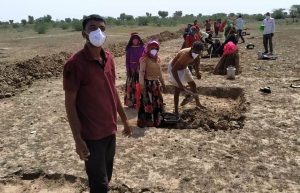
Rajasthan is a state which has biggest geographical area in India (10% of total country’s area) out of it 54% area is not suitable for agriculture so cultivable area is only 46% which is predominantly rain fed and one crop is also at risk because it depends on Mansoon which fails in around 70 years in 100 years. We discussed the agriculture and the livestock is 2nd major option of livelihood, as described above that agriculture is suffering from water scarcity because Rajasthan have 1% surface water resources of the country. A healthy livestock practice needs green fodder, healthy livestock practice needs green fodder, productive common grazing land, sufficient crop reduce and sustained fodder crop etc. that is being impossible is in most part of Rajasthan. Apart from Agri. and livestock than corporate won’t interested in Rajasthan special in western part (that have 69% area of total Rajasthan), artisan and handicrafts were failed due to asymmetrical and visionless support by govt.
- To revive agriculture and livestock the surface water conservation done at major scale, leads to zero discharge of rain water in average Mansoon. A large number of families were benefitted through Naada (community farm pond), Talab repaired, Kund dug during the year.
- The 2nd largest livelihood option is livestock so pastureland made productive, encroachment removed and benefit sharing management setup arranged.
- Implementing mitigating poverty project in western Rajasthan (M-POWER) with a set of activates for supporting livelihood with financial help of IFAD, SRTT & GoR. There is 340 SHG formed, almost all member of these SHG trained and loan availed to start new livelihood activity or boost old one.
- 340 SHG linked with bank, 110 families were organized to initiate some small scale enterprises under M-power project.
- 3278 members were trained to run their SHG smoothly so that group can handle economic development activities.
- 48,91,400 has facilitated as loan from project to 127 SHG, 11 SHG have livelihood plan and 3 have executed properly.
- 98 Exposure tours were organized to show off better livelihood in practices.
Key Achievement:
Loan of Rs. 48,91,400 from bank on a lower interest rate is availed to 1397 families to meet out household expenses. 121 families are running income generating activities with a small scale and land base enterprises. Rs. 21 Lacks is total saving of 340 groups and 3740 members. All these are not enough to reduce poverty or enhance livelihood but it leads to that. The capacity enhancement is not merely limited to theoretical part but it have practical work as well because rural poor have slow learner in theoretical way of training.
GVNML deployed 62 committed staff in livelihood program that shows that it is one of major concern of the area.
- GVNML’s famous model of conserving nature has significant support to livelihood, it revive agriculture, livestock at th
ose families who are losing it. So as 25% families of 18 villages are resettled with their own occupation.
- The annual income of around 800 families has grown up by 30 thousand through restoration of pasture lands, uplifting ground water and improvises the decision taking system within village.
- The CPRs of 95 villages were made productive, people based benefit sharing system were created and timely maintenance/care taking were setup. It has benefited 1650 families in arranging land b
- 75 youth from poorest of the poor families have trained to initiate some kind of skill based livelihood out of 75, 20 youth have started own work of stitching through small shop and 14 got service as security guard.

Looking Forward:
The livelihood is added as a new thematic area of GVNML so strategy and programmatic design will be worked out in upcoming year. Anyhow two major sections will be basic area of work:
- Land based (Agriculture, Animal, water) are main area of intervention. GVNML will focus on small and marginalized farmers and herders to stabilize their primary occupation and enhance livelihood support system. Micro level plan will be worked out for 60-80 villages in coming year and execution will be done as per plan to get desired result.
- The second sector of GVNML’s livelihood theme is based on SHG that will be facilitated through credit and small scale enterprises. GVNML have around 450 SHGs so with that mas of 4950 families, 50% families will be covered to initiate some sort of small enterprises, some sort of skill-based livelihood and credit based promotional initiative for existing livelihood.
